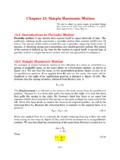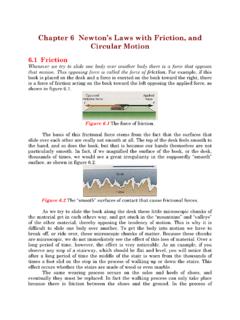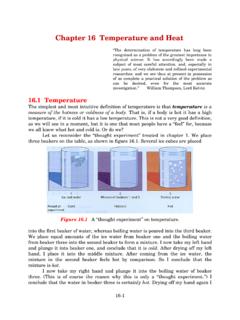Transcription of Chapter 10 Gravitation - Planetary and Satellite …
1 Chapter 10 Gravitation - Planetary and Satellite Motion Newton s Law of Universal Gravitation It is sometime said that Newton observed an apple fall from a tree and immediately discovered the law of gravity. This is, of course, an oversimplification. Newton did observe that when any object, such as an apple, was released near the surface of the earth, it was accelerated toward the earth. Since the cause of an acceleration is an unbalanced force, there must, therefore, be a force pulling objects toward the earth.
2 If you throw the apple, or any other projectile, at an initial velocity v0, as seen in figure , then instead of that apple moving off into space in a straight line as Figure Motion of an apple or a projectile. Newton s first law dictates, it is continually acted on by a force pulling it back to earth. If you were strong enough to throw the apple or any projectile with greater and greater initial velocities, then the projectile paths would be as shown in figure The distance down range would become greater and greater until at some Figure The same force acting on a projectile acts on the moon.
3 Initial velocity, the projectile would not hit the earth at all, but would go right around it in an orbit. But at any point along its path the projectile would still have a force acting on it pulling it down toward the surface of the earth just as it had in Chapter 10 Gravitation - Planetary and Satellite Motion 10-2 figure Figure shows a page from the translated version of Newton s Principia showing these ideas. Figure A page from Newton s Principia. Newton extrapolated to the conclusion that the same force that causes the apple to fall to the earth also causes the moon to be pulled to the earth.
4 Thus, the moon moves in its orbit about the earth because it is pulled toward the earth. It is falling toward the earth, just as the apple falls to the earth. If there is a force between the moon and the earth, why not a force between the sun and the earth? Or for that matter why not a force between the sun and all the planets? Newton proposed that the same gravitational force that acts on objects near the surface of the earth also acts on all the heavenly bodies.
5 This was a revolutionary hypothesis at that time, for no one knew why the planets revolved around the sun. Following this line of reasoning to its natural conclusion, Newton proposed that there was a force of Gravitation between each and every mass in the universe. Newton s law of universal Gravitation was stated as follows: between every two masses in the universe there is a force of attraction between them that is directly proportional to the product of their masses, and inversely proportional to the square of the distance separating them.
6 If the two masses are as shown in figure with r the distance between the centers of the two masses, then the force of Figure Newton s law of universal Gravitation . attraction is Chapter 10 Gravitation - Planetary and Satellite Motion 10-3 F = Gm1m2 ( ) r2 where G is a constant, called the universal gravitational constant, given by G = 10 11 N m2 kg2 We assume here that the radii of the masses are relatively small compared to the distance separating them so that the distance separating the masses is drawn to the center of the masses.
7 Such masses are sometimes treated as point masses or particles. Spherical masses are usually treated like particles. Note here that the numerical value of the constant G was determined by a celebrated experiment by Henry Cavendish (1731-1810) over 100 years after Newton s statement of the law of Gravitation . Cavendish used a torsion balance with known masses. The force between the masses was measured and G was then calculated. Gravitational Force between Two 1-Kg Masses Newton s law of universal Gravitation says that there is a force between any two masses in the universe.
8 Let us set up a little experiment to test this law. Let us take two standard 1-kg masses and place them on the desk, so that they are 1 m apart, as shown in figure According to Newton s theory of Gravitation , there is a force between these masses, and according to Newton s second law, they should be accelerated toward each other. However, we observe that the two masses stay right where they are. They do not move together! Is Newton s law of universal Gravitation correct or isn t it? Figure Two 1-kg masses sitting on a table.
9 Chapter 10 Gravitation - Planetary and Satellite Motion 10-4 Let us compute the gravitational force between these two 1-kg masses. We assume that the gravitational force acts at the center of each of the 1-kg masses. By equation , we have F = Gm1m2 = 10 11 N m2 (1 kg)(1 kg) r2 kg2 (1 m)2 and therefore the force acting between these two 1-kg masses is F = 10 11 N This is, of course, a very small force.
10 In fact, if this is written in ordinary decimal notation we have F = N A very, very small force indeed. (Sometimes it is still worth while for the beginning student to write numbers in this ordinary notation to get a better feel for the meaning of the numbers that are expressed in scientific notation.) If we redraw figure showing all the forces acting on the masses, we get figure The gravitational force on mass m2 is trying to pull it toward the left. Figure Gravitational force on two 1-kg masses.














